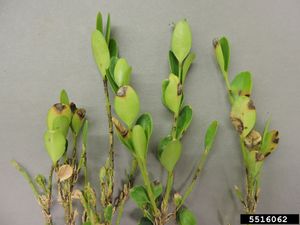Calonectria pseudonaviculata
| Literature database |
|---|
| 63 articles sorted by: |
| • year (recent ones first) |
| • research topics |
| • countries/regions |
| • host plants |

Author(s): Mary Ann Hansen, Virginia Polytechnic Institute and State University
Source: IPM Images
Calonectria pseudonaviculata (Crous, J.Z. Groenew. & C.F. Hill) L. Lombard, M.J. Wingf. & Crous (2010) - (boxwood blight)
The fungus infects Buxus plants in Europe and other regions. For example, it has been recorded in North America since 2011 (Elmhirst et al., 2013). The typically symptoms are a foliar blight, accompanied by dieback and the formation of dark narrow stem cankers. It can also cause crown and root rot if roots and crowns are directly exposed to relatively high inoculum levels. Microsclerotia would be formed under these conditions.
Microsclerotia remain viable for at least 40 weeks and conidia for several weeks (Dart et al., 2015). The latter are hyaline with single septations and rounded on both ends, ranging in size from 45 to 65 µm with a width of 4-5.5 µm.
Synonyms:
Cylindrocladium pseudonaviculatum
Cylindrocladium buxicola